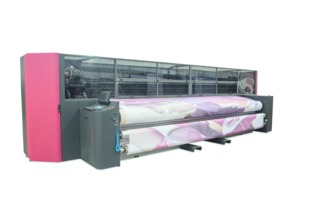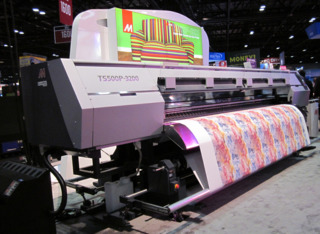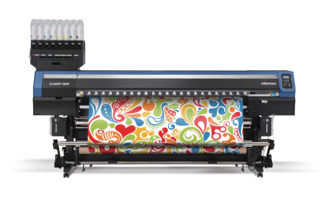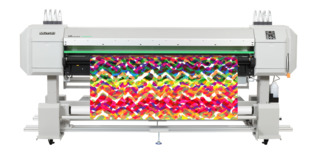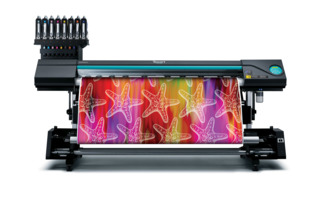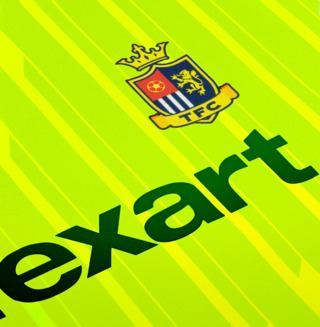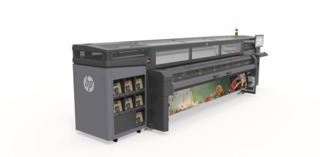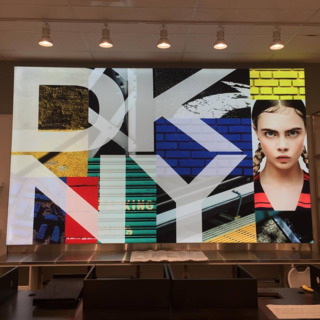Fabric and Soft Signage Take the Retail and POP Markets by Storm
The exploding number of products, hardware as well as consumables, makes digital textile printing more accessible than ever.
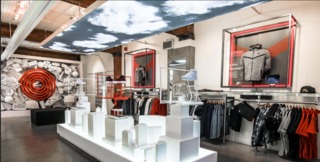
Are you noticing more fabric signage in retail stores, corporate lobbies, and tradeshows lately? There’s a good reason: Fabric printing and soft signage have been on a growth spurt for a number of years. As in the famous Christmas carol, “Let It Snow,” it shows no signs of stopping.
According to Keypoint Intelligence, within the North American wide-format sector, dye-sublimation (textile) printing is the largest growth area, with a CAGR from 2015-2020 of 32%. While the range of applications is vast – from flags and uniforms to massive wall murals and tradeshow graphics – it is the retail and P-O-P markets that have been the focus of so much intense interest and investment lately.
What are some of the upgrades and advances in this market that you need to know?
While the price tag on high-end hardware has not changed significantly over the past few years (up to $750,000), at the entry level, printers can now be purchased for less than $10,000. In all categories, these devices are printing at higher resolutions, at faster speeds, and in wider widths than ever before. Manufacturers have also upgraded these machines with significant productivity enhancements.
But it’s perhaps the ease of installation and transport for fabric-printed graphics and soft signage that’s driving the most enthusiasm. Because fabric signage is significantly lighter than traditional vinyl, soft signage is easier and less expensive to ship. Equally important, it’s easier to hang. Display systems like silicone edge binding systems let clients hang their own displays and avoid professional installation. This opens the door to larger signage and signage that is changed out frequently since customers can often do the installation themselves.
Addressing ownership costs, barriers, and more
The big story for many shops, however, is lowered total cost of ownership. Mimaki is just one example. Within the last year, the company has launched the TS30-1300 54-inch entry-level dye sublimation transfer printer (MSRP starting at $9995); the TX300P-1800 75-inch direct-to-fabric printer (MSRP starting at $36,995); and the TS500P-3200 3.3-meter dye-sublimation transfer printer. It has also previewed the TX500P-3200DS, a superwide direct-to-fabric printer expected to be available in early 2017. All of these machines boast productivity enhancements that are designed to save time and money.
“Depending on the model, these solutions give the user the ease of unattended use with both transfer paper (dye sublimation) or direct-to-fabric,” notes Tommy Martin, product manager, textile and apparel business development and marketing, Mimaki USA.
All three of the Mimaki machines offer advanced technologies such as Nozzle Check Unit (NCU), which automatically detect and clean clogged print head nozzles, and Mimaki’s Nozzle Recovery System (NRS), which automatically uses only the unclogged nozzles as substitutes when the nozzles are not recovered after a head cleaning. These features are performed automatically during the print process without operator interruption and loss of production.
Some of the new models include external ink supply units with larger capacities (2L 0r 3L depending on the model) that, in a 4-color configuration, automatically switch to the alternate backup tank when a color runs empty.
Other productivity enhancements include Advanced Media Feed/Take Up Systems (AMF) for both paper and textile operations that stabilize feeding and take up where print transport is critical during the print process. “The variable feeding and tension control means less production time lost, fewer defective prints and more unattended printing,” Martin explains.
We are also seeing manufacturers looking to lower the barrier to entry by producing value-engineered machines that allow print providers to get into the market at the mid-range.
Among those introducing entry-level machines is Mutoh, whose Dual Head Direct to Textile machine, the ValueJet 1938TX, offers a 75-inch width and prints directly onto fabric at a range of up to 914 square feet per hour.
“The textile and dye-sublimation markets can be a little scary to get into if you’re not familiar with them,” notes Michelle Johnson, advertising and events manager for Mutoh. “These machines make it really easy to start fabric and transfer printing while at the same time increasing production for those who are already in the market.”
The ValueJet 1938TX prints on closed, open non-stretch, face-in, and face-out roll media. It is an 8-color machine with an open ink platform rated to print at 1440 dpi.
At last fall’s SGIA Expo, Mutoh offered a “sneak peek” of its upcoming four-head dye-sublimation machine, the ValueJet 1948WX (the 1938WX is already available).
EFI has made introductions of its own in this market. Its 1.8- and 3.4-meter EFI Vutek FabriVU dispersed dye-sublimation ink printers use water-based inks to produce high-quality signage and banner applications at speeds up to 5381 sq. ft/hr in resolutions up to 2400 dpi. Users gain the advantage of being able to print direct to fabric and on transfer material using the same inksets. And at its 2017 Connect conference, EFI launched the 5-meter FabriVU 520 printer, designed to provide users with new capabilities for producing a broad range of soft-signage products – from wall murals to theater drapes and other superwide seamless applications. The printer can produce up to 4,800 square feet/hour, and print at resolutions up to 2400 dpi. As with its smaller FabriVU brethren, the 520 can execute both direct-to-textile and transfer printing with an easy changeover using the same inkset. The printers are manufactured by EFI’s Reggiani textile printer operations in Italy. EFI also offers additional models, including the EFI Reggiani ONE and EFI Reggiani PRO printers – available for established soft-signage production facilities looking to drive even higher volumes.
HP has also been focusing on increasing speed and efficiency and expanding the accessories to its wide-format printers, including an inline spectrophotometer. It has added continuous printing to condensate removal to control waste and to speed the printing process.
Its new Latex 500 Series printers are designed for medium-to-large PSPs with increasing print volumes. The new 64-inch Latex 560 and 570 enable customers to manage a variety of print jobs and peaks in production at a low upfront investment.
New features include more unattended printing with a new spindle-less pivot table, automatic skew adjustment to load rolls in one minute or less, and heavy-duty roll handling of rolls up to 55 kg (121 lbs.). The machine can print at speeds up to 23 m2/hr (248 ft2/hr) in indoor mode and can produce highly saturated prints in new vivid print modes with 50% more ink density. It also features a new wiper roller accessory for high-quality results on low-cost banners and self-adhesive vinyl.
The 126-inch Latex 1500 Printer, HP’s superwide printing solution, prints at speeds up to 74 m2/hour (800 ft2/hr) in outdoor production mode and up to 45 m2/hour (800 ft2/hour) in indoor mode.
Expanded ink and substrate sets
New inks and substrates are having a significant impact on the market, too.
Inks are being added to expand the color gamut and broaden the range of applications. In mid-2016, for example, Roland DGA released a new fluorescent ink formulated for its Texart XT-640 and RT-640 wide-format dye-sublimation printers. The new inks, Fluorescent Pink (Fp) and Yellow (Fy), can be combined with its Texart process ink colors to produce hundreds of fluorescent hues. The proprietary Roland Fluor Color Library swatch palette can be installed in Adobe Illustrator and CorelDRAW to facilitate ease of use and customization of colors. Texart ink, which won a Product of the Year award at SGIA 2016, is touted for its ability to produce photographic-quality images with subtle skin tones and extremely vivid colors.
Mimaki has added fluorescents to its palette, as well. These include fluorescent yellow and fluorescent inks for the TS300P-1800 76-inch dye-sublimation transfer printer. It now offers a wider range of colors and spot colors, including light black, orange, red, violet, pink, and gray. (Available colors depend on ink types.)
Wider substrates also are being introduced to expand the application sets for superwide projects.
Fisher Textiles, for example, has introduced a new line of 16-foot-wide fabrics for dye-sublimation, UV, and direct disperse printing designed to complement the superwide printers being introduced.
“End users want larger panels without seams,” explains Sharon Roland, advertising and public relations manager for Fisher Textiles. “For superwide projects, wider fabric saves money and time during the printing and sewing processes. Wider material means fewer rolls need to be switched out during the print process and less labor and fewer materials are used to sew multiple panels together.”
For most shops, time is largely spent fabricating rigid or heavy displays and large booth structures. By incorporating a digital textile process, they can substitute large components of the structure with fabric to minimize the weight and bulk. This can save significant cost in material handling. “As a bonus, fabric panels can enable some areas of backlit panels, providing another dimension to the display,” says Roland.
Fisher’s 16-foot fabric is being used in wall and ceiling track systems for conference rooms, large offices, lobbies, atriums, and restaurants. “Printed fabric helps add dimension to architectural environments and makes them more visually appealing,” says Roland.
The takeaway
The takeaway for print service providers? If you’ve been looking for a reason to get into wide-format printing for soft signage and textiles, you may have found it. The exploding number of products, both on the hardware and consumables sides, is making digital textile printing easier and more cost-effective than ever.
McRae Imaging: High Above the Rim
It’s only appropriate that during last year’s NBA All-Star Weekend in Toronto – a time when the NBA’s best players were flying high above the rim in the game, as well as in the exhibition contests – that McRae Imaging was contracted for a lightbox-based fabric project that would enable Nike store customers to feel a little closer to the sky themselves.
McRae designed and constructed the aluminum extrusions for the suspended lightbox structure as well as the proprietary LED lighting system (using Samsung LEDs) for the lightbox interior. The Toronto-based firm then turned to its 3-meter EFI Reggiani ReNOIR dye-sub printer to output the cloudscape onto Lux fabric. McRae worked with client Astound Group in executing the installation, ensuring that the final project was a perfect slam dunk. The entire job was turned around in less than 2 days – from design and build, to print and install.
“We’re seeing many opportunities for the non-traditional when it comes to retail,” says Bob Murray, McRae chairman and CEO. “Companies like Nike are innovators, and they want that same innovation to be seen in their stores by their customers. So we’re seeing applications such as our hanging lightboxes being used in retail applications as well as other sites.”
Established in 1965, McRae Imaging (mcrae-imaging.com) started as a photographic color lab and now produces digital fabric printing, display hardware, and lighting solutions for its extensive client roster. It operates from its 50,000-square-foot facility located just outside of Toronto.

